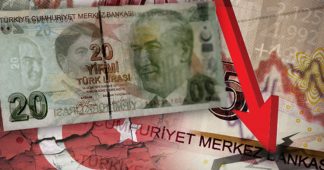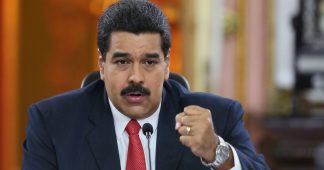By Deepal Jayasekera
18 August 2018
With the ongoing crisis involving Turkish lira, the Indian rupee fell to an all-time low on Tuesday. The Indian currency dropped to the level of 70.1 to the US dollar and ended at 69.93 at the end of the day, recording its largest one-day fall in five years.
Indian officials have attempted to downplay the severity of the crisis confronting the Indian economy and its currency. Economic Affairs Secretary Subhash Chander Garg told the media on Tuesday that there was “nothing at this stage to worry” about the fall of the rupee as it was due to “external factors.” He claimed that India had sufficient foreign exchange reserves to withstand the decline.
At the same time, Garg admitted that the country’s central bank, known as the Reserve Bank of India, was limited in what it could do to contain the fall. He said: “As currencies of other economies are also depreciating, intervention by the Reserve Bank of India, by selling dollars in the country, will not help much at this stage for stabilising the rupee.”
Indian officials have been forced to admit their inability to control “external factors” on the country’s economy. According to Garg, the Reserve Bank of India (RBI) has spent about $US23 billion so far in this year in its attempt to stabilise the rupee.
The fall of the Indian rupee has been unfolding over several months, in response to moves by the US Federal Reserve to lift interest rates and end its “quantitative easing,” thus reversing the flow of relatively cheap dollar-denominated loans. The Indian currency has declined about 8 percent so far this year. Now, amidst the sharp fall of the Turkish lira, which underscores the far-reaching implications of an upward movement of the dollar as a result of the US Fed’s moves on so-called emerging markets, the decline of the Indian rupee is accelerating.
Pointing to the role of foreign investors in the fall of the rupee, B. Prasanna, group executive and head of ICICI Bank, said: “The swift move [of the rupee] past 69 happened due to foreign portfolio investor (FPI) outflows and the need to hedge existing short dollar positions in the market, driven by global market sentiment rather than actual importer demand.”
The decline of Indian rupee is a part of global rush by investors away from so-called emerging markets. Radhika Rao, an economist at DBS Bank in Singapore, said: “The fall in rupee was not in isolation, rather a part of the broader sell-down in emerging markets currencies.”
As a further indication of the growing economic crisis confronting the Indian elite, the country’s trade deficit rose to $18 billion last month, from $16.6 billion in June. The major factor was the increase in oil prices. India imports more than 80 percent of its crude-oil needs.
Some sections of Indian big business welcome a weaker rupee as a favourable factor for exports, arguing that it will make the country’s products competitively cheaper in the world market. Anand Mahindra, the executive chairman of the Mahindra Group, which has interests ranging from cars to construction equipment to insurance, tweeted: “With this boost to India’s export competitiveness could we now convince global companies that it’s time to switch to India for world-scale, export-focused manufacturing?”
However, a weaker rupee will not favour all sections of Indian industries as argued by Mahindra. Those which rely on imported raw materials, component parts and machinery will face increases in their manufacturing costs in rupee terms.
Moreover, a weaker rupee could lead to higher inflation under conditions of increases in import bills of crude-oil, commodities, electronic items and engineering equipment. According to the Indian oil ministry, every rupee change in the exchange rate against the US dollar makes a change of 108.8 billion rupees ($1.58 billion) in the country’s crude-oil import bill, which reached $12.4 billion in July, 57.4 percent higher than a year ago.
While Indian officials boast the country’s foreign reserves are sufficient to push back against the downward pressures on the rupee, the current level of about $402 billion would not cover import costs for a year.
The global economic shocks will intensify the political crisis confronting the government of Prime Minister Narendra Modi. The Hindu supremacist Bharatiya Janatha Party (BJP) will face national elections next year. Its ability to allocate spending toward some cosmetic social policies, in an effort to retain support, is increasingly limited.
The higher inflation resulting from the depreciation of the rupee will intensify the already immense burden on the working people and rural poor in the form of increasing prices for fuel, food and other essential goods and services. It will lead to a further escalation of class struggle.
This year, significant sections of workers and the oppressed have engaged in strikes and mass protests over the attacks on their wages, jobs and working conditions, by both the national BJP government and administrations at state level. Bank employees throughout the country, public-sector bus workers in the southern state of Tamil Nadu, cab drivers attached to major taxi companies Uber and Ola, and farmers in western, eastern and northern India were among them.
Immense class antagonisms exist due to the poverty and widening social inequality caused by the pro-investor economic reforms carried out by successive governments since 1991. The top 1 percent of country’s population enjoys nearly a quarter of all income and owns 60 percent of the country’s total wealth, under conditions where about 70 percent of the population lives on less than $2 a day. Only a tiny minority of big bourgeoisie and privileged section of upper middle class has benefited from more than a quarter century of economic reforms in the expense of vast majority of workers and oppressed masses.
India’s social powder keg is on the verge of explosion under conditions where the main opposition Congress Party and the Stalinist parliamentary parties—the Communist Party of India (Marxist) or CPM and the Communist Party of India (CPI)—are discredited among the workers and oppressed masses due to their role in imposing pro-investor economic policies and associated austerity measures. These organisations will not be able to contain working-class resistance as they have in the past.











